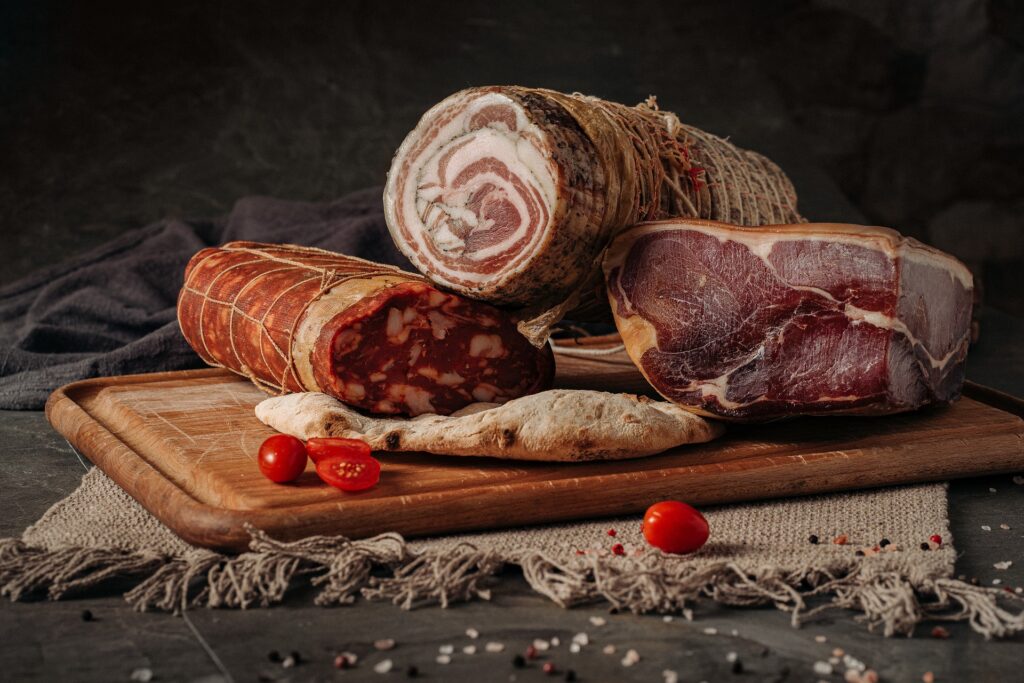

Meat, fish, dairy products and eggs… I am going to talk here about animal products: and to see what place they could take in the diet.
This is not a chapter that takes into account ethical issues (although I will still talk about them) but rather gives information to guide those who have made the choice not to be vegetarian or vegan.
The goal is always to move towards more freedom, autonomy, conscious and well-being.
Meat is not forbidden in Ayurveda. On the contrary, it can be advocated in some cases.
But still, in Ayurveda, meat is tamasic.
What is tamasic?
Foods that increase inner darkness and confusion are called tamasic foods.
Tamasic foods include fried and frozen foods, fast foods, microwaved foods, processed foods, leftover foods, meat, fish, eggs, onions, alcohol, etc. They are good for slowing us down, numbing us, depressing us and reinforcing inertia.
If consumed in large quantities and regularly, they tend to depression, to laziness, overeating, excessive drinking, and excessive sexual desire.
Ayurveda has defined 3 qualities of food, but it is not the topic of today.
Animal products, the worst and the best…
One of the big challenges of our diet is the micro-nutritional richness and we generally think in terms of fruits and vegetables. But it is too often ignored that animal products are very rich in micronutrients, provided that the animals themselves have consumed suitable and rich food.
If the animal was raised healthy, outside, in the sun, ate grass, with a diet rich in micronutrients, this will be found in its flesh. Raised in good conditions, an animal’s liver is a micro-nutritional bomb, because the liver stores vitamins and a good part of the minerals.
Conversely, an animal that grazes on grass treated with pesticides and fungicides will concentrate these toxic products, particularly in its fatty part. It’s the same with antibiotics. This is how we find fish loaded with heavy metals. The bigger the animal, the more it will have eaten, and the more these products will be concentrated in its flesh.
If the animal was raised in good conditions, its flesh will therefore be rich in micronutrients which are also particularly bioavailable. We are very well equipped to digest animal products, much better than for vegetables whose cellulose can be problematic.
In animal products, we therefore find both the best and the worst. In the worst case, there are also the problems of protein overload in the event of too much consumption of this family of foods. What will especially be interesting are the animal fats in which there are many fat-soluble vitamins and provided that they are introduced in suitable quantity and quality.
What Are the benefits to consume animal products?


The benefits of consuming animal products are real provided that the animals have been raised in good conditions. The more an organism is weakened, the more difficult it is for the person to do without animal products.
Indeed, a tired person finds it difficult to digest, assimilate and use the nutrients found in plant products. While a person who has a very good vitality will undoubtedly adapt to a vegetarian or vegan diet.
In ayurveda meat and bones meals are often use to elevate bone imbalances like arthrosis, breaks, osteoporosis… with special soup.
A food plan intended for tired, chilly, depressed people includes animal products in order to compensate for possible deficiencies with a diet composed only of plants.
Eggs: an ideal product?
All animal products are not equivalent in terms of digestibility and impact on the environment. Focus on food quality. So we will speak exclusively of organic animals, raised in the open air, grass-fed for herbivores and which have received the physiological diet corresponding to their species. It is an essential base.
Among animal products, eggs are foods that is really interesting. Already we can produce them at home very easily, they do not require killing an animal. It is a kind of partnership between the hen and the human being.
The egg is a complete food.
The egg yolk is rich in very high quality processed fats, loaded with fat-soluble vitamins. Egg white provides highly digestible proteins. From experience, the less it is cooked, the better it is. Cooking tends to alter the quality of the yolk in particular. Cooking makes proteins more digestible but decreases nutritional quality.
It is very easy to consume a raw egg. For example, you can beat it to incorporate it into a salad dressing. Raw egg yolk can also be used to prepare mayonnaise.
Choose organic eggs at a minimum, ideally from farms near you where the hens are free-range. You should be able to find some in the markets.
Milk and its modern problems


Animal milk contains a great wealth of nutrients. It is composed mainly of sugars (lactose), proteins (casein) and fats. When talking about dairy products, it is imperative to specify what exactly we are talking about.
People allergic to dairy products are in fact mostly allergic to casein which is a protein found in dairy products.
This clarification is very important because butter contains practically no casein because it is made up of milk fat.
Please note: there is a huge difference between raw dairy products and pasteurized dairy products. These can be stored at room temperature because the microbial life has completely disappeared. And it is the microbes that ensure the decomposition and transformation of the product, thus improving its digestibility. In addition, pasteurized milk has lost all of its enzymatic content and has seen its micro-nutritional content greatly altered.
In the fresh section, you can find unpasteurized milk.
What about fermented milk product
Another feature to consider is fermentation. Traditionally, peoples who consumed a lot of milk fermented it in order to initiate a process of predigestion and thus make it much more digestible. A fermentation of 36 to 48 hours in the old way will also be much more favorable than a modern short fermentation of less than 12 hours (which is found even with organic yoghurts). Kefir and cheeses have a very long fermentation.
Finally, the breed of dairy cows also has a strong influence on the digestibility of these products. The casein in the milk of traditional cows raised naturally has nothing to do with those of cows found in factory farms.
In summary, it is better to give preference to fermented, organic dairy products whose animals have been raised in the open air.
Among the fermented milk products, there are:
– Preferably yoghurts to lengthen the fermentation time,
– Strainers or goat’s cheese
– Kefir is a milk in which mushrooms have always been added to initiate this pre-digestion process
– Artisan cheeses raw milk
From more to less allergenic, we find cow’s milk, sheep’s milk and lastly goat’s milk. Prefer goat’s milk if possible, sheep’s milk is also good but richer in fat.
Ghee from butter is a very interesting product, especially if it is a butter made from raw milk from naturally raised cows. Ghee is devoid of toxins unlike butter.
All these products will be consumed without cooking in your diet. You can optionally melt butter on hot food.
Above all, be free not to consume dairy products if they do not appeal to you.
Can we do without meat?
We generally associate a healthy diet with vegetarianism.
Can we do without meat?
The answer is: it depends! It depends on your body’s ability to find enough mineral, micro-nutritional, protein and fatty acid sources in the plant products you are going to consume. For some, it will go very well, for others, especially for tired people, much less well.
In animal products, there is a highly assimilable elaborated iron which is absent from vegetable products. And in general, the animal has the ability to transform micronutrients to make them more assimilable by our body than those from plants
How to consume meat “at best”?
Raw or cooked, raw is fine.
It’s not about eating meat dripping with blood!
Traditionally the meat was gamed. It was a maturation process in which all the bacteria and micro-organisms naturally present in the tissues carried out the work of decomposition, allowing better digestibility.
You are already used to eating raw meat: raw sausage and ham are among them.
How to prepare fermented raw meat at home?
Simply place it in a dehydrator for a few hours (30° max) then keep it cool (cool cellar or well-ventilated refrigerator) away from insects and let it mature for 1 or 2 weeks. White mold growing on the surface is completely normal. The thinner the pieces, the more successful your “homemade” cold cuts will be. If you put large pieces it is necessary to have a well ventilated, very dry refrigerator to prevent inadequate molds from developing there. Your sense of smell cannot deceive you in this matter. Meat that goes bad smells extremely bad.
Preparation of raw meat
– dried and matured for a long time preferably
– marinated in vinegar or lemon
– fresh in tartar
The advantage of this technique is that it does not add salt or sugar or any preservative as in charcuterie.
Raw meat contains many enzymes which are destroyed during cooking. When meat is cooked on the barbecue or in a frying pan, this cooking changes the composition of the meat and forms compounds that are known to participate in the formation of cancer cells. Moreover, when you grill meat, you lose the fat, which represents the most interesting part of animal products.
With raw, cured meat, you’ll retain that fat that gives the meat its flavor. And of course, you will keep all the micro-nutritional richness present.
What about all the pathogenic bacteria like Escherichia Coli?
It must be understood that on the surface of all plant and animal products there is a huge contingent of bacteria that guarantees the microbial stability of the products you are going to consume. So if an animal has been injected with antibiotics, the meat from that animal is susceptible to attack by any bacteria present in its storage environment.
From experience, I have never seen bacterial contamination of meat provided you follow proper meat aging techniques. That is to say surface drying and maturation at less than 7 or 8°. Above 10° you take risks. Let’s also not forget that the hydrochloric acid in our stomach is there to sterilize our food bowl.
It is also possible to eat raw and fresh meat. For example, you can mix an egg yolk with a minced steak to obtain a steak tartare. But drying and curing raw meat is one of the best ways to consume raw meat.
You can also marinate raw meat in acid products (lemon, vinegar) for a few hours. The acidity will lead to a start of nutrient decomposition to improve assimilation (but not as elaborately as with maturation).
And for seafood?


The oceans are unfortunately increasingly polluted and even if they have the ability to self-clean, there is today an imbalance between the quantity of pollutants discharged into the sea and its ability to eliminate them. Consuming products from the sea therefore leads to exposure to all these pollutants. The bigger a fish, the more its flesh will concentrate pollutants (aluminum, mercury, pesticides, heavy metals, etc.). Small fish are therefore preferred.
Preparation of raw fish
– fresh && raw seafood
– oily fish dried and matured for a few hours
– marinated in vinegar or lemon
If we put aside the problem of the inevitable pollution of these products, fish and other seafood have their place in the diet. Most seafood can be eaten raw. Oysters of course, mussels, clams, … oysters are very rich in minerals.
When we talk about eating raw fish, we usually think of oily fish because the others, once dried and marinated, have very little taste. Raw fish can be eaten in the same way as meat.
You can fillet sardines or mackerel, dehydrate them and put them in the fridge or put them whole (but having previously emptied them and having removed the head). Consume them within hours (or even a few days at most) because the fatty acids tend to go rancid and give an unpleasant taste.
Raw fish can be marinated in vinegar or lemon. There are many traditional recipes that you can take inspiration from.
If you decide to consume animal products, choose them of organic and from free-range animals.
But why still consume animal products these days? I’m not going to decide for you on an ethical level, I’m here to talk about nutrition and Ayurveda. The animal seems to me a very important step between nature and humans.
Personally, the ideal mode of operation for my farm if I get one would be to have hens and a few sheep or goats to make butter, as plant production can be unpredictable from one year to the next.
But again, whether or not you include animal products in your diet is up to you.
Find more info on my blog
Take care, ba kind, compassionate and love.
Namaste
